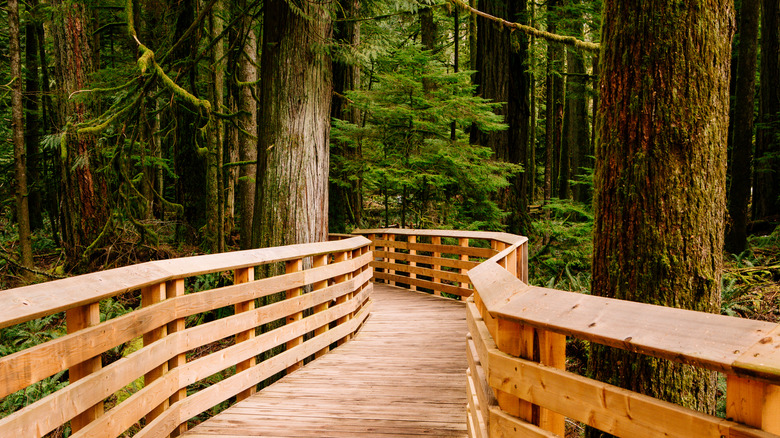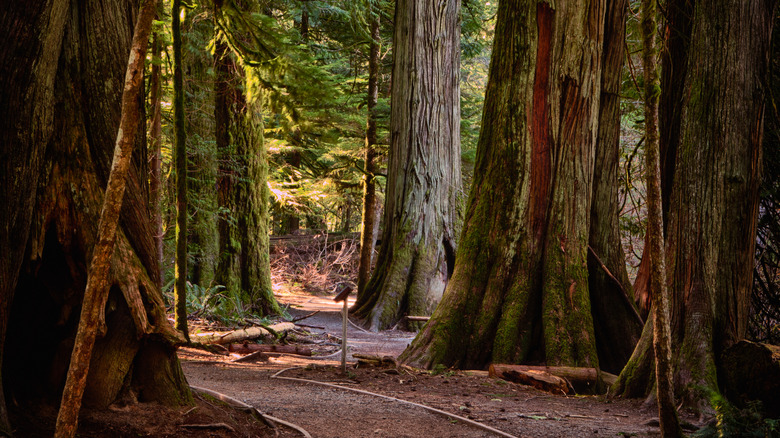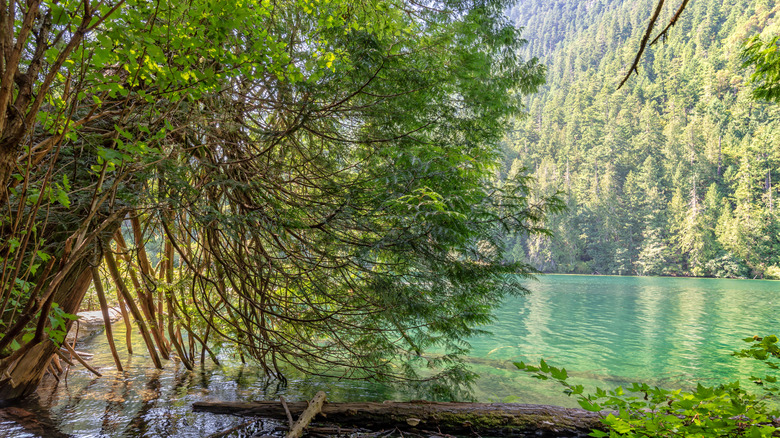The Underrated Park On Vancouver Island With The Silent Strolls You've Been Begging For
Canada is known for its friendly people, low population density, and peaceful wilderness, so it probably wouldn't surprise you to learn that the Great White North is one of the safest countries in the world. Yet, in a land brimming with natural beauty, Vancouver Island stands out. Fringed with beaches along the Salish Sea and Pacific Ocean, it's full of old-growth rainforest, sparkling waterfalls, tranquil lakes, and plenty of charming towns and cities if you need a quick escape into civilization.
An ideal spot to explore the tranquil trails of this beautiful island is at MacMillan Provincial Park, particularly the area called Cathedral Grove, located centrally on the island between the towns of Port Alberni and Coombs. It was established as a Class A provincial park in the 1940s to preserve some of the island's oldest and tallest trees, which were under threat due to increased logging. The forest was a tourist favorite for years before it officially became protected, and was essential to the local tribes for thousands of years before that.
A cathedral of trees ideal for peace in nature
MacMillan Park isn't just a park, it's a cathedral! A cathedral of trees, that is. The park used to be known as Cathedral Grove, although technically, now Cathedral Grove is just one section of the park, containing the native forest famous for its giant and ancient trees. The paths through the park are lined with huge Douglas firs, some reaching heights of 250 feet and dating back 800 years. You'll also see western red cedars (which the indigenous peoples considered sacred because of their life-giving properties) as well as grand firs and western hemlock.
This old-growth rainforest is one of the few remaining on Vancouver Island, which used to be covered in such forest prior to the arrival of the logging industry. It's also the most accessible place on the island to see these remarkable trees, as you'll be able to immerse yourself in the forest almost instantly after leaving the parking lot. The park spreads on both sides of Highway 4, best reached as you drive toward the scenic west coast of the island, with the Old Growth Trail to the north, and the trails of Big Tree and Living Forest to the south.
Although Cathedral Grove can get crowded, you can leave other tourists behind on some of the lesser-traveled trails within the park for those silent strolls. To avoid the crowds further for your meditation in nature, visit in the shoulder season (May and September).
Amazing trails, lakes, wildlife, and Indigenous history
The highlight of any visit to MacMillan Park and Cathedral Grove are the trails among the trees. Beautiful on sunny days when the sun filters through the canopy, and equally beautiful with vibrant greens in rainier weather, plan to spend several hours wandering in its majesty. Walking along Big Tree Trail, you'll see the park's widest tree: A Douglas fir with a circumference of 29 feet! On Old Growth Trail, you'll find the start of a short trail to the turquoise Cameron Lake. Vancouver Island is a great destination if you're hoping to see wildlife, and Cathedral Grove is no exception. The Cameron River flows through the park and is home to native fish species like rainbow and cutthroat trout. You'll also spot a large variety of birds, like woodpeckers and owls, along with other animals like deer, elk, and even black bears or cougars.
In addition to its natural beauty, the park is also a site of cultural history. It has been home to local First Nations groups for centuries, including the Te'mexw, K'ómoks, and Tseshaht tribes. These peoples have been faithful stewards of the land while relying on its natural resources for their livelihoods, such as for canoes (and other transportation), shelter, and clothing. MacMillan Park is also significant as a successful example of citizens lobbying the government for environmental protection. Recognizing the significance of Cathedral Grove as an important location and a popular tourist destination as early as the 1920s, the public spent many years trying to convince the provincial government to grant the area federal protection status, which it finally did in the 1940s.


